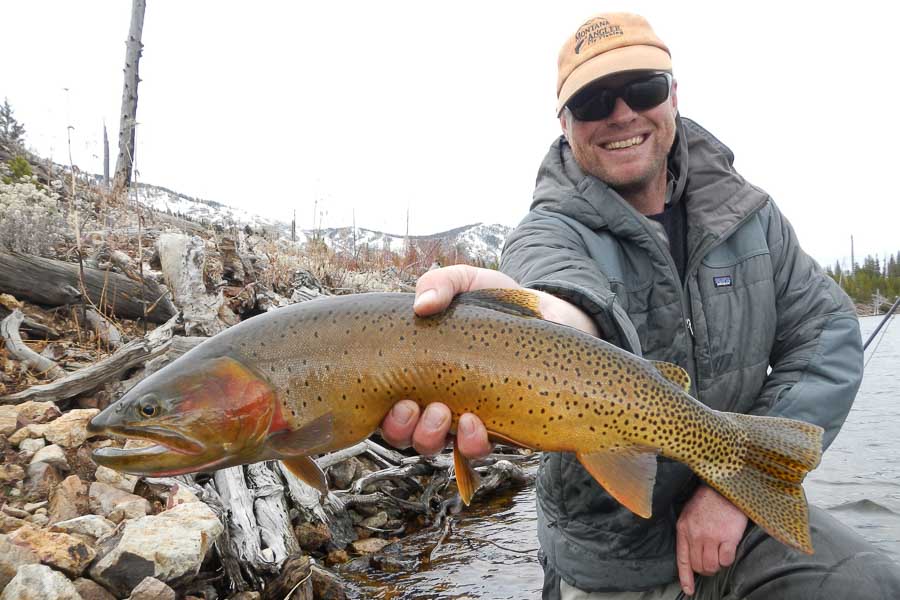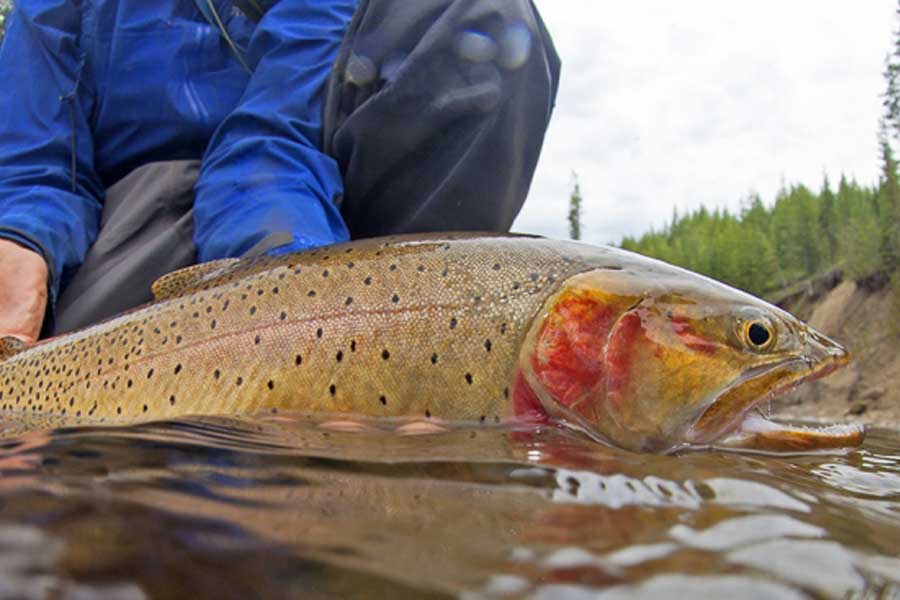Yellowstone Lake is an impressive body of water. Covering 136 square miles, it is easily the largest body of water in Yellowstone Park and among the largest natural lakes in the United States. At nearly 8,000 feet in elevation, Yellowstone Lake is the largest high-altitude lake in North America. The lakes’ deepest point reaches 394 feet and the water temperature remains in the 40’s during the heat of summer. Once a tremendous fishery for the native Yellowstone Cutthroats that call it home, Yellowstone Lake has been devastated by a burgeoning population of illegally introduced Lake Trout. The Lake Trout were officially discovered by the Park Service in 1994, but rumors of their presence had existed for years. The fishery collapsed during the late 90’s, with spawning runs in key tributaries showing declines of over 90% according to the National Park Service. An aggressive Lake Trout suppression program is currently underway, and the fishery is showing signs of improvement. Over 300,000 Lake Trout were captured and killed during both 2012 and 2013 according to park authorities. While it would be virtually impossible to eliminate them completely, the goal is to reduce Lake Trout numbers to the point where do not negatively impact Cutthroats in a significant manner.
Special Note: All Lake Trout caught in Yellowstone Lake must be killed. It is illegal to release a Lake Trout back into Yellowstone Lake.
Fly-Fishing Yellowstone Lake in Yellowstone National Park
Although it is a shadow of its former self, Yellowstone Lake still offers the angler the chance to catch a large trout. Most of Cutthroats range from 18-22” and the Lake Trout run slightly larger on average. While you shouldn't expect big numbers, the fishery is slowly improving and the realistic chance at a 20”+ native Cutthroat doesn't exist in very many other places.
Yellowstone Lake opens to fishing on June 15 and fishing for Cutthroats is generally best during the early part of the summer immediately after the opener. Lake Trout fishing is best during the fall, when the fish move into shallower water to spawn. Lake Trout are a deep dwelling fish and are generally not available to the fly angler during much of the year, though gear anglers can do well on deep diving lures.
Stripping streamers is by far the best tactic on Yellowstone Lake. Streamer fishing allows the angler to cover a lot of water, which is critical in such a large body of water with a relatively low fish population at the moment. Streamers also key in on the predatory instinct of the large trout that reside in the lake. A baitfish pattern like a Clouser Minnow or a general streamer like a Wooly Bugger is a great place to start. For colors, I like olive, black, and white. A dash of red can be effective as well, as it mimics the tell-tale Cutthroat slash. My general set up is a 6 wt rod with an intermediate sinking line and a short, stout leader of about 3 feet of 8-10 lb tippet. I like to give my fly a chance to sink before I begin my retrieve, which is done at a slower pace than you would retrieve your streamer when fishing in a river. Finding the right depth and speed of retrieve is much more critical than your fly pattern, so experiment and change those variables first.
Yellowstone Lake - Where to Fish?
Yellowstone is a huge lake, with ample access provided by road, trail, and boat. Choosing a spot to fish can seem like a daunting task, as most of the lake is both deep and uniform. For the shore fisherman, the most popular area by far is around Gull Point Drive, located just south of Bridge Bay Marina. This one way road provides access to the southern part of Bridge Bay, and fishing around the point allows fly anglers access to deep water near the shore. Fish cruise around the shelves and drop offs when they are on the feed. Shallow, protected areas around points are also key areas. These types of features can be found in many areas of the lake, and it is up to the angler to explore and look for them. Generally speaking, the Bridge Bay and West Thumb areas give anglers the best combination of fish numbers and access.
If you are interested in fishing for Lake Trout in the fall, the National Park Service has extensive data on Lake Trout spawning patterns and locations and they are more than happy to share this information with anglers. A quick phone call can get you dialed in on where to fish. The area around Carrington Island is well known Lake Trout spawning ground that can be fished from shore, and would be the best place to start absent other information from the park service or local anglers.






